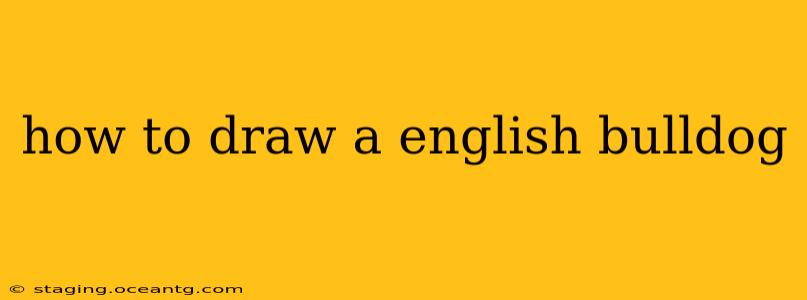The English Bulldog, with its distinctive wrinkled face and stocky build, is a popular subject for artists of all skill levels. This guide will walk you through drawing one, step-by-step, focusing on capturing its unique characteristics. Whether you're a beginner or more experienced, you'll find tips and techniques to improve your bulldog drawing.
Understanding the Bulldog's Anatomy
Before you start sketching, it's crucial to understand the bulldog's key features. Observe reference images – photos are excellent – paying close attention to:
- The Head: Broad, square head with prominent wrinkles. The muzzle is short and undershot (lower jaw protrudes).
- The Body: Compact and muscular, relatively low to the ground. The chest is broad and deep.
- The Legs: Short and sturdy, slightly bowed.
- The Tail: Short, thick, and often curled.
Step-by-Step Drawing Guide
Let's start with a simple, foundational approach:
1. Basic Shapes: Begin by sketching light, basic shapes to represent the overall form. Think of a circle for the head, a rectangle for the body, and smaller circles and rectangles for the legs. Don't worry about details at this stage; focus on proportions and overall structure.
2. Refining the Head: Within the head circle, lightly sketch the muzzle, eyes, and ears. The eyes are set wide apart, and the ears are typically rose-shaped (folded over). Pay close attention to the wrinkles around the eyes and muzzle – these are key features of the breed.
3. Defining the Body: Using your initial rectangle, refine the body shape, adding curves to suggest the chest and back. Lightly sketch the legs, maintaining their short and sturdy appearance. Remember that the bulldog's body is compact and muscular, not elongated.
4. Adding Details: Now it’s time to add the finer details. Refine the wrinkles on the face and forehead. Add shading to suggest the muscles in the legs and body. Draw in the short, thick tail.
5. Refining and Shading: Once you're happy with the basic form, start refining the lines and adding more detail. Use shading to give your bulldog dimension and depth. Pay attention to the light source and how it affects the shadows and highlights. Consider adding texture to the fur.
H2: What materials do I need to draw an English Bulldog?
You can use various materials to draw an English Bulldog. Pencils (ranging from H to B for different levels of darkness) are excellent for sketching and shading. You can also use charcoal for a bolder, more dramatic effect. Consider using a kneaded eraser to lift graphite and refine details. Paper should be suitable for the medium you're using; heavier-weight paper is generally preferable to prevent tearing or smudging.
H2: How can I make my drawing look realistic?
Achieving realism in a bulldog drawing lies in understanding the anatomy and paying close attention to detail. Study reference images carefully, paying particular attention to the wrinkles, muscle definition, and proportions. Proper shading and highlighting techniques will enhance the three-dimensional effect. Consider using a range of pencil grades or charcoal to create variation in tone and texture.
H2: What are some common mistakes to avoid when drawing an English Bulldog?
Common mistakes include:
- Incorrect proportions: Ensure the head is large and square relative to the body.
- Neglecting wrinkles: The wrinkles are essential to the bulldog's appearance; don't underestimate them!
- Overly simplified features: Don't be afraid to add detail to the eyes, muzzle, and ears.
- Lack of shading: Shading gives your drawing depth and realism.
H2: Are there any online resources that can help me learn how to draw an English Bulldog?
Numerous online resources can assist you. Search YouTube for "how to draw an English bulldog" for video tutorials. Websites like Pinterest and DeviantArt showcase various drawing styles and techniques that you can learn from. Remember, consistent practice and observation are key to improvement.
By following these steps and focusing on the unique characteristics of the English Bulldog, you'll be well on your way to creating a captivating and realistic drawing. Remember, practice makes perfect!
